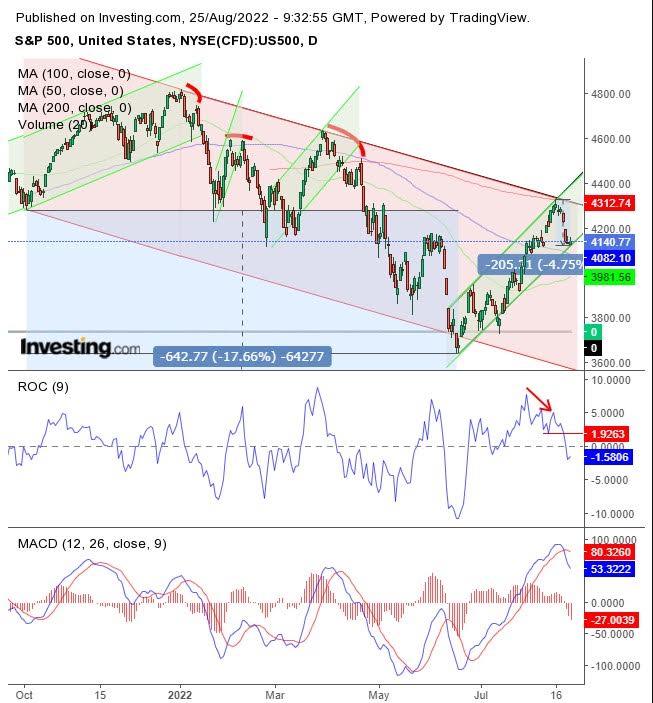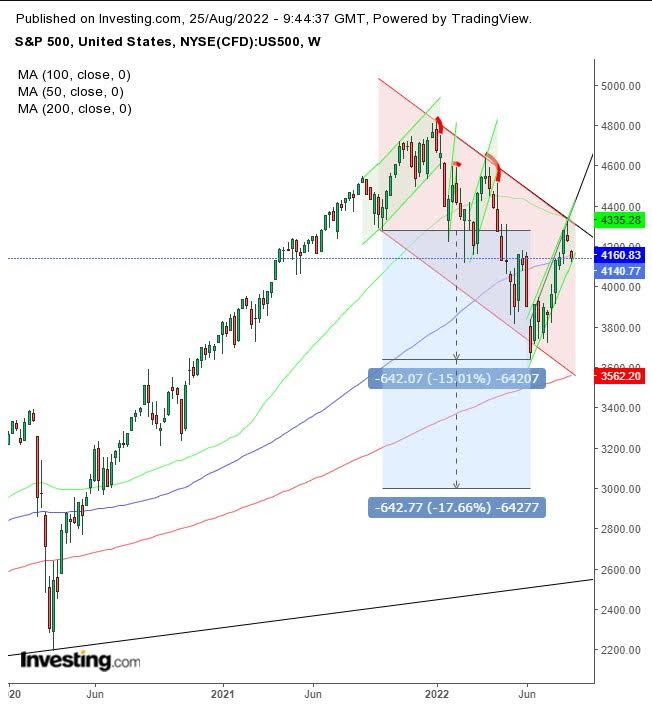This post is the first of three series in which I will provide a top-down exploration starting today with the S&P 500 index. Barring dramatic market developments, I will analyze a subindex on Monday and then a specific stock within the subindex the following day.
The top-down approach is a funneling process to find the best, or in this case, the worst stock.
The S&P 500 sold off this week as repeated warnings by Federal Reserve speakers rattled bulls who were betting the central bank would pivot.
Before that, the popular gauge surged as bulls charged from the June 16 low. And July provided the best S&P 500 performance since November 2020 with the index rallying 9.11%.
Including gains since the July 16 low, The SPY ETF gained 18.83% from July 16 to its August 16 high, just 1.17% away from registering an official bull market. The uptick was driven by bulls as oil prices topped out on June 14, strengthening the view that inflation was reaching a high. In addition, May factory orders rose more than expected, and corporate earnings were not as bad as feared—not necessarily positive just not as bad as expected.
At the same time, investors seemed to ignore corporate profit warnings and shrugged off negative GDP growth for two consecutive quarters, the definition of a recession.
US Federal Reserve Chair Jerome Powell said he didn't think the US was headed into a recession because "too many areas of the economy that are performing too well." And President Joseph Biden dismissed the very notion saying:
"There's going to be a lot of chatter today on Wall Street and among pundits about whether we are in a recession, but if you look at our job market, consumer spending, business investment, we see signs of economic progress in the second quarter as well."
The primary economic indicator Powell and Biden kept referring to was employment. The US economy added 398,000 jobs in June and 528,000 jobs in July and the unemployment rate was just 3.5%.
However, housing is always the first economic indicator to respond to increasing rates while employment is one of the last. Home prices fell last month for the first time in three years, posting their biggest decline since 2011 and new data is suggesting a 4% drop in 5 months. So, Powell should know better.
While earnings drove the recent rally, policymakers' repeated warnings about continuous tightening caused the selloff which followed. Investors are concerned that Fed members have been prepping the market ahead of Powell's speech in Jackson Hole this Friday.
The S&P 500 Index entered a bear market in June. A bear market is when the main trend is downward and any rallies are just corrections. If you're impressed with the fact that July was the index's best month since November 2020, remember that it followed its worst first half since 1970. That gives some perspective.
Therefore, the current rally is just a bear rally, or a bull trap, probably driven by retail trading, feeling the subsequent significant unwinding of longs and shorts by institutions.
Back in June, Societe Generale and Goldman Sachs warned of further stock declines "in 70s style stagflation," an economy beset by slow growth, high unemployment, and rising prices. SocGen warned that the S&P 500 could fall another 24% from the June lows to 3,020, "in line with its historical post-crisis market valuation trendlines," according to 150 years of history.
Now, if SocGen's forecast concerns you, let's look at the chart.

If you're impressed with the rally's uptrend, you can see that it's a blip within the much longer and broader downtrend. Each time the price reached the channel top, it broke the short-term formation and resumed the underlying downtrend.
Note that the 200 DMA reinforces the channel top. The indicators are bearish. The MACD provided a sell cross as the long MA drops below its short MA. The ROC triggered a negative divergence, as momentum failed to support the second half of the advance since the July low.
Now, do the technicals agree with SocGen's fundamental outlook?
After last week's shooting star found resistance by the 50-week MA, the price slipped blow the 50 WMA this week. The next major MA, the 200 awaits at the bottom of the channel as if directing the price were to go. If the index repeats the previous decline between the two lows that form the channel, a 642-point drop, the next one will be at the 3,000 mark. Note that the long-term trendline rising from the depths of the 2008 crash is ascending to that point.
Still, the price doesn't move in a straight line. I expect the price could rebound off the (green) rising channel's bottom to retest the (red) falling channel's top. Note that each time the price reached the top, it attempted a second rally, which failed to reach the first. The price formed an inverted hammer on Tuesday, whose bullishness it confirmed on Wednesday with a close above the hammer's real body. There may remain interest in the 4,100 levels of congestion from early in the month by the 100 DMA.
Trading Strategies
Conservative traders should wait for the price to form a lower peak and fall out of the short-term rising channel.
Moderate traders would short the second peak.
Aggressive traders could enter a contrarian, long position, taking advantage of an attractive risk-reward balance due to the proximity to the support. Then, they'd join the rest of the market with a short position.
Trade Sample
Aggressive Long Position:
- Entry: 4,125
- Stop-Loss: 4,100
- Risk: 25 points
- Target: 4,200
- Reward: 75 points
- Risk-Reward Ratio: 1:3
Disclaimer: The author currently does not own any of the securities mentioned in this article.
